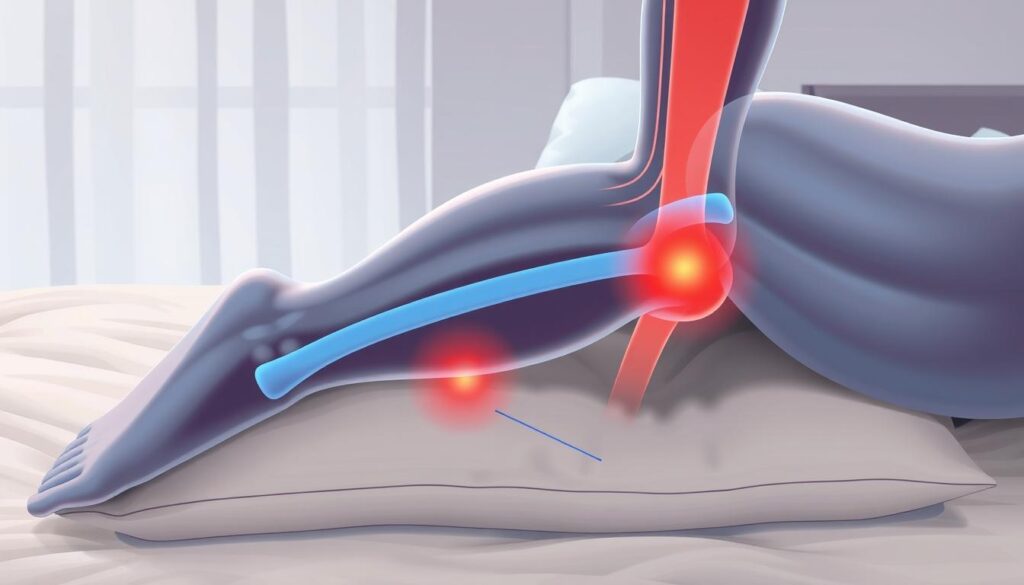If you are in pursuit of the best sleeping position for IT band pain, selecting the right sleeping position can make a big difference. This guide will help you find the best way to sleep for IT band pain relief. You’ll learn about the IT band, its symptoms, and how good sleep helps in recovery. Key Takeaways Understanding IT band pain is essential for effective relief. The right sleeping position can help manage discomfort. Proper sleep positively impacts muscle recovery. Supportive pillows can enhance sleep quality. Establishing healthy sleep habits is key to long-term relief. Understanding IT Band Pain Understanding IT band pain is key for those with thigh or knee discomfort. The iliotibial band, or IT band, is a key stabilizer for the knee. It connects the hip to the knee, aiding in smooth movement during exercise. What is the IT Band? The IT band is a thick band of fascia, mainly made of connective tissue. It helps keep the knee stable and mobile. It’s vital for activities like running, cycling, and other exercises that involve leg motion. Common Causes of IT Band Pain Several factors can lead to IT band pain, causing discomfort. Common causes include: Overuse during physical activities such as running or cycling Tight muscles, mainly in the hips and quadriceps Improper footwear that fails to provide adequate support Uneven surfaces that increase strain on the IT band Muscle imbalances from inadequate stretching or strengthening Knowing these causes can help prevent more irritation and manage IT band discomfort better. Cause Description Overuse Repetitive actions in sports or exercise Tight Muscles Insufficient flexibility leading to strain Improper Footwear Shoes that do not provide necessary support Uneven Surfaces Increased stress on the IT band during activity Muscle Imbalances Weakness or tightness in certain muscle groups Signs You May Have IT Band Pain Knowing the signs of IT band pain is key to managing it well. Several symptoms can show you have this condition. These symptoms can affect your physical activities and daily life. Symptoms to Look For Common symptoms of IT band pain include: Lateral knee pain, often felt during movement or physical activity Swelling around the knee joint Tenderness along the outer thigh A popping or snapping sensation while bending the knee When to Seek Medical Advice It’s important to seek medical advice IT band pain if you feel persistent discomfort. You should see a healthcare professional if: The pain doesn’t get better with usual self-care methods The pain gets worse over time Swelling or big mobility issues happen An illustration depicting a side view of a human leg highlighting the iliotibial band, with emphasis on areas of discomfort, showing subtle signs like redness or inflammation. Include a background of a peaceful bedroom setting to suggest the context of sleep. The leg is resting on a soft pillow, with a slightly bent knee, and an anatomical approach showcasing the muscles and tendons around the IT band area. Spotting these signs and symptoms helps you take action early. Quick action can stop the condition from getting worse. It also helps you get back to your daily activities more easily. The Importance of Sleep for Recovery Understanding how sleep impacts recovery is key for those with IT band pain. Sleep is more than just rest; it’s a time for the body to heal. It helps repair muscles, release growth hormones, and control inflammation. The quality of sleep greatly affects how well you recover. How Sleep Affects Muscle Recovery During sleep, the body fixes itself and helps muscles recover. Growth hormone, which helps grow and repair muscles, is released most during deep sleep. Not getting enough sleep can slow down muscle repair, leading to longer soreness and slower recovery. People looking to recover muscles fast should focus on getting enough sleep. Aim for the recommended hours of restful sleep each night. The Connection Between Rest and Pain Relief A well-rested body means better pain relief. Quality sleep improves overall well-being. It also helps manage stress and emotions, which can worsen pain. Good sleep habits can reduce pain, making daily life more comfortable. This leads to better performance in daily activities. Best Sleeping Position for IT Band Pain Choosing the right sleeping position can greatly improve comfort for those with IT band pain. Knowing the good and bad of each position helps find the best one for IT band pain. Side Sleeping: Pros and Cons Side sleeping is often seen as the best for IT band pain. It helps keep the spine aligned and reduces pressure on the affected area. Some benefits include: Reduces stress on the IT band. Helps maintain a natural curve of the spine. Facilitates easier breathing. But, side sleeping might cause discomfort in the shoulders or hips for some. So, a good mattress and pillow are key. Back Sleeping: A Comfortable Option Back sleeping is another good choice for IT band pain. It supports the spine and spreads out body weight evenly. It allows for: Minimal strain on the back and joints. Easy adjustments with supportive pillows. Encouragement of spinal alignment. To get more comfort, try a pillow under your knees for extra support and relief. Avoiding Stomach Sleeping Stomach sleeping is not recommended for IT band pain. It can put too much strain on the spine and worsen pain. Issues include: Risk of spinal misalignment. Increased pressure on the neck and back. Potential aggravation of existing pain. By avoiding stomach sleeping, you can lower the chance of making your pain worse. Additional Techniques for IT Band Relief During Sleep Looking for ways to ease IT band pain can make your sleep better. Using pillows and stretching before bed can help. These methods reduce pressure and help your muscles heal. Using Pillows for Support Using pillows in the right way can help your IT band during sleep. Here are some tips: Knee Pillow: A pillow between your knees when sleeping on your side keeps your hips aligned. This reduces IT band stress. Hip Support: […]

